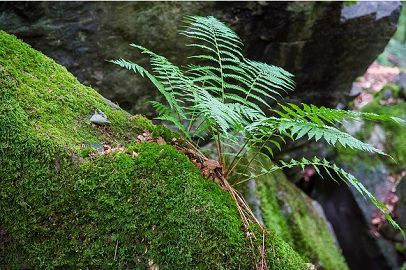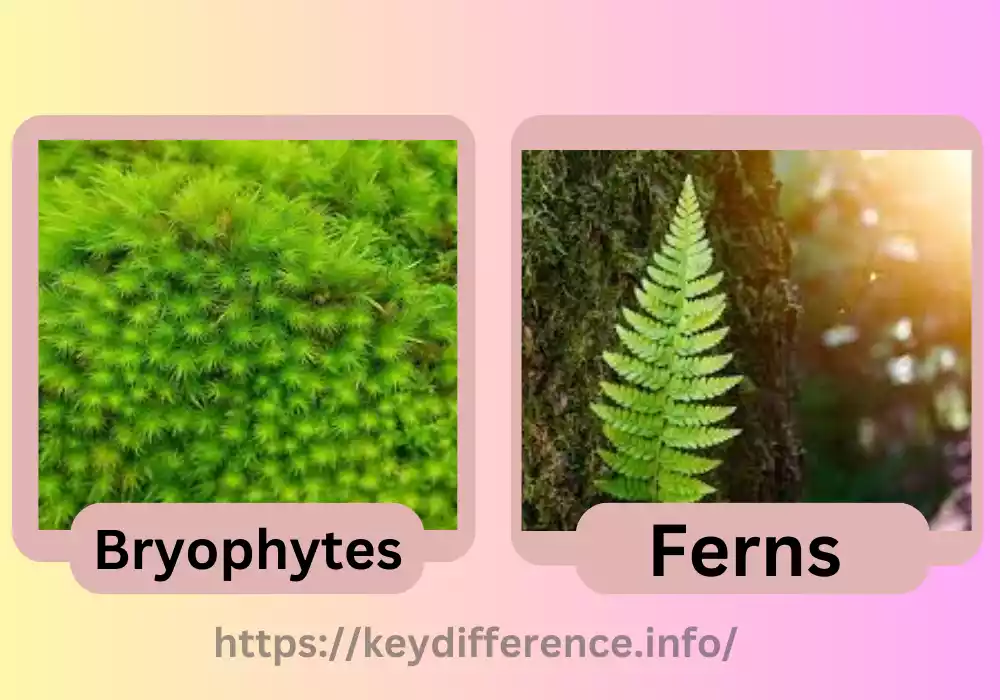Bryophytes and Ferns
Bryophytes and Ferns are two distinct groups of plants, with unique characteristics and ecological functions. The Bryophytes are non-vascular plant species, which include mosses and liverworts. They lack tissues that transport water and nutrients. The plants are usually small, simple, and dependent on water for their reproduction. Bryophytes are characterized by a predominant gametophyte generation and they play an important role in the ecosystem, including soil stabilization.
Ferns, on the other hand, are vascular plants with specialized tissue for transporting water and nutrients. Bryophytes are smaller and have a more complicated structure. Ferns reproduce by spores and have an overwhelmingly sporophyte-dominated generation. Ferns are well adapted to the terrestrial environment and play an important role in habitat creation and nutrient cycles. They also serve as environmental indicators.
Bryophytes differ from ferns in terms of their structure, reproduction strategies, preferred habitat, and roles within the ecosystem. Ferns have vascular tissues, while bryophytes do not. Bryophytes are dominated by a gametophyte generation, whereas ferns possess a dominant generation of sporophytes. For reproduction, Bryophytes depend on moisture. Ferns reproduce via spores. Bryophytes are best adapted for moist habitats, while ferns can adapt to a variety of terrestrial environments.
It is important to understand these differences for eco-studies, conservation, and practical application. Ferns are useful in medicine, horticulture, and the industrial sector. The differences between bryophytes, ferns, and other plants provide insights into the plant kingdom as a whole, its adaptations, and the contributions of humans and ecosystems.
Importance of understanding the differences between bryophytes and ferns
Here are some important points:
- Ecological understanding: Ferns and bryophytes play different ecological roles within various ecosystems. Their differences help us understand the unique contribution they make to our environment. Bryophytes are a good example. Their ability to hold water and nutrients is crucial in the formation of soil, erosion control, and the creation of microhabitats. Ferns on the other side, are important for nutrient cycles, they provide food and shelter to wildlife and can be used as an indicator of ecosystem health. Understanding these differences will help us better manage and appreciate ecosystems.
- Conservation and Biodiversity: To accurately classify species and distinguish between the two groups, it’s necessary to make a distinction. This information is crucial for conservation because it helps you assess bryophytes’ abundance and distribution. This knowledge can help develop effective conservation strategies to restore and protect their habitats.
- Evolutionary insights: Ferns and bryophytes are ancient plant lineages that have developed unique traits over many millions of years. Their differences provide valuable insight into the evolutionary history of plants. This includes the transition from nonvascular to vascular plants.
- Practical Applications: Bryophytes, for example, are used to measure the quality of ecosystems in relation to air and water. As they are highly sensitive, these sensors can be used to monitor pollution. Due to their unique characteristics and ornamental value, ferns are useful in landscaping, gardening, and horticulture. Knowing their differences will allow you to use them appropriately in the fields.
- Science Research: The differences between bryophytes, ferns, and other plants provide a fertile field for research. Investigating their reproduction, genetics, ecology and physiology will help us understand fundamental biological processes. Determining bryophytes’ and ferns’ unique survival and adaptation strategies may also inspire innovation in other fields such as biotechnology, agriculture, and medicine.
This knowledge enhances our ability of us to manage and protect plant diversity, ecosystems and biodiversity.
Definition of Bryophytes
Bryophytes are a division of non-vascular plant species. These small herbaceous plants lack the specialized tissue for transporting water and nutrients, i.e. xylem or phloem. Bryophytes are divided into three groups, mosses and liverworts.

The Bryophytes are simple plants that lack roots, leaves and stems. They have instead rhizoids which are roots-like structures anchoring the plant to the substrate, and absorbing water and nutrients. The plants reproduce by spores, and their life cycle is dominated by a gametophyte. Gametophytes are haploid and produce male and female gametes which fuse together to create a diploid zygote. The zygote becomes a sporophyte which is still attached to the gametophyte. It produces spores within a capsule called sporangium.
In humid habitats such as forests or wetlands, Bryophytes are common. They play a vital role in ecosystems, forming soil and retaining moisture. Also, they create microhabitats. These insects are very sensitive to environmental changes and act as indicators.
Classification and Characteristics of Bryophytes
The Bryophytes group is a non-vascular plant that has unique features and plays an important role in the ecosystem. The bryophytes are divided into three major types, mosses (phylum Bryophyta), hornworts, and liverworts.
The classification of bryophytes and their key features are listed below:
Mosses (Phylum Bryophyta):
- The largest bryophyte group, mosses can be found worldwide in many habitats.
- The leaves are arranged spirally around the central stem.
- Mosses can reproduce sexually or asexually. The production of eggs and sperm is required for sexual reproduction. Asexual reproduction is achieved by fragmenting plant parts and forming specialized structures known as gemmae.
- The haploid gametophyte, which is more prominent and autonomous in the life cycle of mosses, dominates the gametophyte. The gametophyte is attached to the sporophyte, which has a seta-like stalk and capsules containing spores.
- These plants are well-adapted to humid environments, where they play an important role in soil formation, water retention and the creation of habitats.
Liverworts (Phylum Marchantiophyta):
- The liverwort is a small flattened plant that grows in a variety of habitats including aquatic, terrestrial and epiphytic.
- The thalli are flattened leaves-like structures. The thalli may be segmented or lobed.
- These combine to create a zygote. Asexual reproduction is achieved by gemmae or special structures known as gemmae.
- As with mosses and liverworts, the dominant generation is the gametophyte, while the attached sporophyte remains on the gametophyte.
The Hornwort (Phylum Anthocerotophyta):
- The sporophytes of hornworts resemble horns.
- The thallus of these organisms can either be elongated, or it may flatten out. They often form a relationship with the cyanobacteria that fix nitrogen.
- Hornworts can reproduce sexually or asexually. The fusion of female and male gametes forms a zygote in sexual reproduction. Asexual reproduction is achieved by the formation of special vegetative structures known as gemmae cup.
- The sporophyte of hornworts is unique and resembles an elongated horn. The photosynthetic sporophyte continues to grow during the entire life cycle of the plant.
- Bryophytes are non-vascular plant species that have unique reproductive and structural strategies. The Bryophytes are non-vascular plants with unique structures and reproductive strategies. They play an important role in ecology, have evolved to thrive in moist conditions, and possess a dominant generation of gametophytes.
Definition of Ferns
Ferns belong to the Pteridophyta division. The sporangia are their distinctive reproductive structures that produce spores. Ferns have a developed system of vascular tissue, including the xylem and phloem. This allows them to transport water and nutrients efficiently throughout their plant.
The fronds of ferns are large leaves that have been divided into sections. They serve as the photosynthetic cells. The fronds can be of different shapes, from undivided to complex structures. Ferns reproduce by spores produced on the margins and undersides of fronds. The spores, once released, are dispersed and, if they land in an environment that is suitable, develop into the gametophyte. Gametophytes produce sperm, eggs, and zygote which fuse together to create the next generation of sporophytes.

The dominant generation of ferns is the diploid, which has a more independent and visible stage in its life cycle. The sporophyte can either be herbaceous, or woody. Gametophyte production is smaller, and it depends on the sporophyte to provide nutrients and water.
Ferns are found throughout the world, from humid forests to deserts. Ferns contribute to the functioning of ecosystems by providing habitat for wildlife, aiding in soil erosion prevention, and preventing nutrient cycle. Ferns can be distinguished by the large, divided leaves, their unique reproduction structures, and their vascular tissues. The ferns have evolved to adapt to many terrestrial habitats and are important in the ecosystem.
Classification and Characteristics of Ferns
Ferns belong to the Pteridophyta division of vascular plants. The classification of ferns and their key characteristics are as follows:
Leptosporangiate Ferns:
- Leptosporangiate Ferns make up 95% of all known species of fern.
- The leptosporangium is a special reproductive structure that produces spores. The spores produced by these fungi are dispersed and released to create a new generation of gametophytes.
- The photosynthetic cells of Leptosporangiate Ferns are their large divided leaves, called fronds.
- Rhizomes are underground stems that give rise to the fronds. The rhizome is responsible for nutrient and vegetative transport.
- Leptosporangiate Ferns Examples include maidenhair, sword, bracken, and maidenhair.
Eusporangiate Ferns:
- The Eusporangiate Ferns is a small group of ferns with a unique sporangium.
- The sporangia of eusporangiate and leptosporangiate Ferns are usually larger.
- They are also the organs that perform photosynthetic functions.
- The rhizomes of Eusporangiate Ferns are often horizontally spreading.
- Eusporangiate Ferns include climbing ferns and tree ferns.
The Other Fern Groups
- There are other groups of ferns that have distinct characteristics. These include ferns with leptosporangiate or eusporangiate leaves.
- Marattioid Ferns are primitive, large ferns that have compound fronds. They also possess a special type of sporangium.
- Ophioglossoid Ferns (also known as Adder’s Tongue Ferns) have fertile fronds that are separated from sterile ones. They also bear sporangia along specialized stalks.
- The spores of moonworts or botrychiums are produced in clusters that look like grapes.
Ferns have the following characteristics:
- Vascular tissue: Ferns have specialized tissues that transport water and nutrients, such as the xylem or phloem. They can grow bigger and inhabit a variety of habitats.
- Spore reproduction: Ferns reproduce by spores. These are found in the sporangia that grow on the margins and undersides of their fronds. The spores released are transformed into gametophytes, which produce sperm and egg for sexual reproduction.
- The dominant Sporophyte Generating: In Ferns, the visible stage in their lifecycle is an independent sporophyte. Gametophyte is usually smaller, and it depends on the sporophyte.
- Habitat adaptations: Ferns can adapt to many different terrestrial habitats, from humid forests to deserts. The ferns have developed mechanisms that allow them to adapt to different levels of light, temperatures, and humidity.
- Ecological Importance: Ferns are important for ecosystem functioning. They provide habitat and food to animals and aid in the nutrient cycle.
Ferns, as a group of diverse vascular plants are classified in the Pteridophyta division. The ferns exhibit a variety of characteristics including sporangia types, frond structure, and growth patterns. Ferns are vascular tissues, they reproduce by spores and their dominant generation is sporophytes.
Comparison table of Bryophytes and Ferns
Here’s a comparison chart outlining the key differences between bryophytes and ferns:
| Characteristics | Bryophytes | Ferns |
|---|---|---|
| Vascular Tissue | Non-vascular plants | Vascular plants |
| Size and Complexity | Small and relatively simple structure | The larger and more complex structure |
| Root-like Structures | Rhizoids | True roots |
| Dominant Generation | Gametophyte | Sporophyte |
| Reproductive Structures | Sperm and eggs | Spores in sporangia |
| Reproductive Dependency | Moisture-dependent for sperm mobility | Independent of water for fertilization |
| Habitat Preferen | Moist environments | Diverse terrestrial habitats |
| Ecological Rolesce | Soil formation, moisture retention, microhabitats | Habitat provision, nutrient cycling, erosion prevention |
| Economic and Practical Uses | Indicators of environmental health | Horticulture, medicine, ornamental plants, industrial uses |
Benifits of Bryophytes and Ferns
Benifits of Bryophytes
The bryophytes (mosses, liverworts, and hornworts) have many benefits for ecosystems. They also offer practical applications. Bryophytes have many benefits.
- Soil Formation and Stabilization: Bryophytes are important in the formation of soil by breaking down organic material and rocks. They also contribute to soil stabilization. The ability of Bryophytes to trap organic matter and retain moisture helps build soil fertility. Their dense growth, mat-like structure, and ability to retain moisture help build soil fertility.
- Moisture Retention: The ability of Bryophytes to retain and absorb moisture gives them a large water-holding capacity. These sponges absorb and store water to prevent excessive loss of water from ecosystems and reduce the likelihood of drought.
- Microhabitat Creation: Bryophytes are microhabitats for a wide range of organisms such as spiders, invertebrates and insects.
- Carbon Sequestration: Bryophytes are dense, cushion-like plants that provide nesting places, protection and moist environments for organisms.
- Indicators of Environmental Health: Bryophytes are important for carbon sequestration. They do this by absorbing atmospheric CO2 and storing in their tissue. They reduce greenhouse gas emissions by growing and accumulating biomass.
- Environmental Health Indicators: Bryophytes have a high sensitivity to pollution and environmental change. Monitor bryophytes to identify air pollution or heavy metal contamination.
- Ecological Research: Bryophytes are valuable models for ecological research. They are studied to determine the impact of environmental change on ecosystems. The unique adaptations and reproductive strategies of these animals provide valuable insights into evolutionary biology and ecosystem dynamics.
Bryophytes are important ecosystem indicators. They provide services like soil formation, moisture control, the creation of microhabitats, carbon storage, and more. It is crucial to preserve bryophyte communities and understand their importance for the health of ecosystems, biodiversity and environmental challenges.
Benefits of Ferns
Ferns are beneficial to ecosystems, and they also have many practical uses. Ferns have many benefits. There are few:
- Habitat provision: Ferns are a habitat for many organisms including small mammals, insects, birds and amphibians. The dense root and frond systems of ferns create microhabitats that provide protection from predators and nesting areas.
- Nutrient Cycling: Ferns are important in the nutrient cycle within ecosystems. They enrich the soil with nutrients as they decay and grow. Ferns decompose organic matter, which helps to maintain soil fertility.
- Solvent Erosion: Ferns’ extensive roots help to bind soil particles, which reduces erosion from wind and water. The ferns’ rhizomes, fibrous roots, and other root systems act as anchors to stabilize soil, which prevents soil erosion and sedimentation.
- Carbon Sequestration: Ferns like all plants photosynthesize carbon dioxide and store it in their tissues. Ferns, as they accumulate biomass and grow, contribute to the sequestration of carbon dioxide, which helps mitigate climate change.
- Ornamental Value and Aesthetic Appeal: Many species of fern are valued because they are beautiful and can be used as ornaments in parks, gardens and even indoor areas. The unique, intricate structures of their fronds add texture and beauty to landscapes and enhance visual appeal.
- Traditional Medicine: Some species of ferns have medicinal properties that are used in medicine for many centuries. Some ferns contain anti-inflammatory or antimicrobial compounds. Different cultures use them for various purposes.
- Ecological Restoration: Ferns can be used to restore disturbed or degraded areas. Ferns are valuable for stabilizing and restoring ecosystems because of their ability to establish and colonize quickly. They also have erosion control capabilities and can cycle nutrients.
Knowing the advantages of ferns can help you recognize their importance in ecology, conserve their population, and use them in various applications such as habitat restoration, sequestration of carbon, or ornamental landscaping.
Summary
Bryophytes are a distinct group of plants, with differences that can be seen in their structure, reproduction strategies, preferred habitats, and ecological functions. As non-vascular, bryophytes have a simple and small structure. Ferns are bigger and more complex since they’re vascular. Bryophytes reproduce by spores, and their dominant generation is the gametophyte, whereas ferns are primarily sporophytic. Bryophytes are adapted to moist habitats, while ferns can adapt to a variety of terrestrial environments.
Bryophytes are important for soil creation and the development of microhabitats, while ferns create habitat, help with nutrient cycles, and prevent soil erosion. Ferns are used in industry, horticulture, and medicine. Bryophytes can be indicators of the health of an environment. It is important to understand these differences in order to appreciate the variety of plants and implement effective conservation and management techniques.

